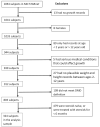Corticosteroid Treatment and Growth Patterns in Ambulatory Males with Duchenne Muscular Dystrophy
- PMID: 27039228
- PMCID: PMC5100357
- DOI: 10.1016/j.jpeds.2016.02.067
Corticosteroid Treatment and Growth Patterns in Ambulatory Males with Duchenne Muscular Dystrophy
Abstract
Objectives: To evaluate growth patterns of ambulatory males with Duchenne muscular dystrophy (DMD) treated with corticosteroids compared with ambulatory, steroid-naïve males with DMD and age-matched unaffected general-population males and to test associations between growth and steroid treatment patterns among treated males.
Study design: Using data from the Muscular Dystrophy Surveillance, Tracking, and Research Network, we identified a total of 1768 height, 2246 weight, and 1755 body mass index (BMI) measurements between age 2 and 12 years for 324 ambulatory males who were treated with corticosteroids for at least 6 months. Growth curve comparisons and linear mixed-effects modeling, adjusted for race/ethnicity and birth year, were used to evaluate growth and steroid treatment patterns (age at initiation, dosing interval, duration, cumulative dose).
Results: Growth curves for ambulatory males treated with corticosteroids showed significantly shorter stature, heavier weight, and greater BMI compared with ambulatory, steroid-naïve males with DMD and general-population US males. Adjusted linear mixed-effects models for ambulatory males treated with corticosteroids showed that earlier initiation, daily dosing, longer duration, and greater dosages predicted shorter stature with prednisone. Longer duration and greater dosages predicted shorter stature for deflazacort. Daily prednisone dosing predicted lighter weight, but longer duration, and greater dosages predicted heavier weight. Early initiation, less than daily dosing, longer duration, and greater doses predicted greater BMIs. Deflazacort predicted shorter stature, but lighter weight, compared with prednisone.
Conclusion: Prolonged steroid use is significantly associated with short stature and heavier weight. Growth alterations associated with steroid treatment should be considered when making treatment decisions for males with DMD.
Keywords: BMI; height; weight.
Copyright © 2016 Elsevier Inc. All rights reserved.
Figures




References
-
- Balaban B, Matthews DJ, Clayton GH, Carry T. Corticosteroid treatment and functional improvement in Duchenne muscular dystrophy: long-term effect. Am J Phys Med Rehabil. 2005;84:843–50. - PubMed
-
- Beenakker EA, Fock JM, Van Tol MJ, Maurits NM, Koopman HM, Brouwer OF, et al. Intermittent prednisone therapy in Duchenne muscular dystrophy: a randomized controlled trial. Arch Neurol. 2005;62:128–32. - PubMed
-
- Biggar WD, Harris VA, Eliasoph L, Alman B. Long-term benefits of deflazacort treatment for boys with Duchenne muscular dystrophy in their second decade. Neuromuscul Disord. 2006;16:249–55. - PubMed
-
- Henricson EK, Abresch RT, Cnaan A, Hu F, Duong T, Arrieta A, et al. The cooperative international neuromuscular research group Duchenne natural history study: glucocorticoid treatment preserves clinically meaningful functional milestones and reduces rate of disease progression as measured by manual muscle testing and other commonly used clinical trial outcome measures. Muscle Nerve. 2013;48:55–67. - PMC - PubMed
-
- Angelini C, Pegoraro E, Turella E, Intino MT, Pini A, Costa C. Deflazacort in Duchenne dystrophy: study of long-term effect. Muscle Nerve. 1994;17:386–91. - PubMed
Publication types
MeSH terms
Substances
Grants and funding
LinkOut - more resources
Full Text Sources
Other Literature Sources
Medical

